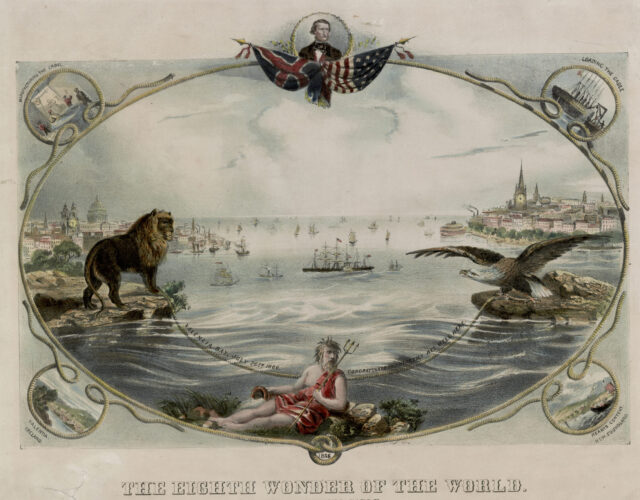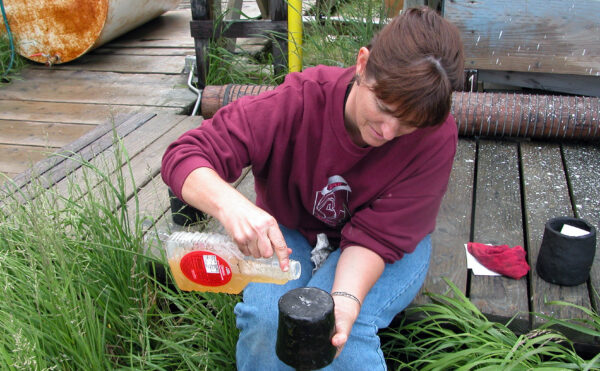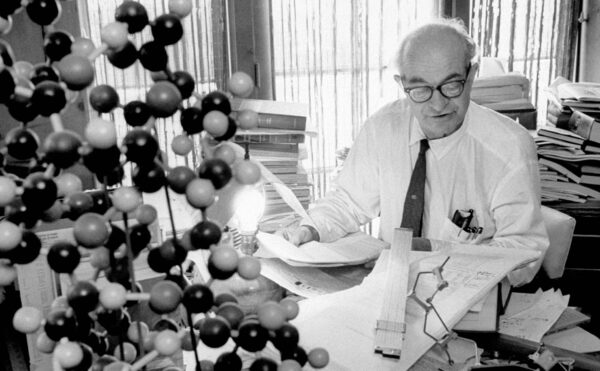In his 1869 futuristic novel, Twenty Thousand Leagues under the Sea, Jules Verne imagined a marvelous electric-powered submarine that explored the mysterious underwater world and its inhabitants. Late in the book the main protagonist, Pierre Aronnax, rhapsodizes over a particular undersea marvel—an electric cable lying on the bottom of the North Atlantic Ocean. Unlike the fictional submarine, the Nautilus, the cable actually existed in the nonfictional world. It was the first major link in what was to be a 19th-century ocean-spanning global communications network that Victorians predicted would prevent misunderstandings between nations, banishing war forever. This physical network, along with less benign attempts at empire building, owed its existence to the coagulated latex of a tree native to Southeast Asia.
In the early 19th century several ways existed to communicate over large distances: homing pigeons, messengers on foot or horse, and even signals using flags or lights. But within 20 years of Alessandro Volta’s invention of the battery in 1800, speculation flowed on how to use electric current to communicate over distances by stopping and starting current in a wire. After William Cooke and Charles Wheatstone built the first railway telegraph in Britain in 1837, the new technology (modified by Samuel Morse) spread quickly throughout Britain, France, Germany, and the eastern United States. Yet Britain, a commercial empire, faced a seemingly insurmountable problem: as an island it could not electrically connect itself to the continent.
Early attempts at insulating wire against water with tarred hemp or India rubber failed. Hope arrived in the form of the milk-colored sap of a Malaysian Palaquium gutta tree. The sap, called gutta percha, is a naturally occurring structural isomer of polyisoprene, also known as “natural rubber” or isoprene rubber, with enough flexibility to bend with a wire when heated and retain its shape when cooled. Gutta percha is also tough, easily absorbing stress at the temperatures found on land or at the bottom of the sea. And equally as important, it is a remarkable electrical insulator.
In 1843 William Montgomerie, a British surgeon in Asia, sent samples of gutta percha to England. The sap came to the attention of William Siemens, a London-based German who forwarded the substance to his brother, Werner, who realized its electrical potential. A Prussian artillery officer with a scientific bent, Werner Siemens was involved in the military’s switch from optical to electric telegraphy. In Prussia engineers laid wires underground, where they were subject to rats’ teeth and damp soil. All efforts to insulate these wires proved unsuccessful until 1847, when Siemens and a collaborator developed a method to permanently insulate wires by pressure-coating them with gutta percha. During the 1848 revolution, to protect against Danish naval incursions, Siemens laid submarine mines connected via gutta percha–insulated wires to a detonator in Kiel Harbor. Though never used to blow up ships, this first underwater use of gutta percha foreshadowed its later military roles.
In 1850 British enthusiasts laid the first submarine cable between England and France. The cable, a 25-nautical-mile strand of copper wire surrounded by gutta percha, transmitted a message to the future French emperor Napoleon III but failed within a few hours after a fisherman hauled up the wire accidentally and broke it. The next year an armored cable was successfully laid between the two countries and proved both popular and profitable. News of events—of arriving and departing ships and their cargoes, and of prices for goods—sped across the English Channel on this cable faster than the wings of carrier pigeons. (The cable worked for 37 years, in spite of such early testing methods as using an engineer’s tongue to measure current.)
Despite its German origins in Kiel Harbor and Siemens’s undoubted talents, undersea cables became almost a solely British industry, thanks to Britain’s lock on gutta-percha supplies and its growing need to keep its world-spanning empire connected. By 1900 the British Secretary of the Treasury described the ocean-crossing cables as the “true nerves of the Empire.”
Spanning Oceans
The success and profit of the English Channel cable encouraged a larger endeavor—connecting Britain and the United States. The potential of undersea cables also helped drive scientific and public interest in what lay below the ocean’s waves. Until the 19th century, oceans had been viewed merely as a way to move between harbors. In 1823 the Encyclopedia Britannica admitted ignorance in its entry on the sea: “Through want of instruments, the sea beyond a certain depth has been found unfathomable.” Unlike land exploration, exploring the deep oceans had never fired the public or the scientific imagination.
The push for a link between Britain and America by entrepreneurial cable promoters changed that. Occasional deep-sea soundings turned into a program to map the depths and heights of the ocean floor. And the public grew fascinated by the sublime successes and the dramatic failures of the undersea cable projects of the 1850s and 1860s, eagerly reading newspaper and magazine accounts of them.
Connecting the countries was no easy feat. An armored Atlantic cable would have to be over 2,000 miles long, be insulated by hundreds of tons of gutta percha, and be laid at almost unimaginable depths. Further, to make and lay cables required vast sums of money. Only the wealthiest governments and companies could afford such costs.
Many thought the dream impossible; many, including well-known scientists, believed that current could not flow that great a distance. However, in 1854 Cyrus Field, an entrepreneur, began stoking public enthusiasm for the project. He persuaded Samuel Morse to support him, along with the U.S. Navy’s Matthew Maury, chief of the U.S. National Observatory and a man who probably knew more about the deep oceans than anyone alive and who could marshal resources for further study. Maury’s research program had already overturned assumptions about the seabed, showing that the sea floor offered high mountains and deep valleys rather than a gradual incline from shallow to deep waters. Fortunately for Field, by 1854 one of Maury’s ships had found a level path on the North Atlantic sea floor, a path Maury described as a “plateau which seems to have been placed there especially for the purpose of holding the wires of the submarine telegraph.”
In 1856 Field founded the Atlantic Telegraph Company with British capital and British expertise. The first two attempts to lay cable from Ireland to Newfoundland (connecting Britain and the United States, respectively), in August 1857 and June 1858, failed. The first cable broke in deep water. In the second attempt the mid-ocean splicing of the two halves of cable failed three times before the effort was called off. But the third attempt succeeded, and in August 1858, U.S. President James Buchanan and Britain’s Queen Victoria clasped electric hands across the ocean. In the flurry of public excitement Field sold several miles of leftover cable to Tiffany & Company Jewelers, which cut up this down-to-earth material into four-inch souvenirs, supplied a certificate of authenticity, and sold them for 50 cents apiece. A perfume reminiscent of ocean spray and flowers was even created in Field’s honor. The Times of London compared the effects of the submarine cable to the discovery of the Americas. Morse called it “the great feat of the century.” Torchlight processions were held in the United States, one of which accidentally set New York’s town hall on fire. The grandiose hopes of the two nations were perhaps best expressed in verse by a magazine, the British Workman:
Stretch North, South, East, and West,
Deep down beneath the surging sea,
High o’er the mountain’s crest.
Stretch onwards without stop or stay,
All lands and oceans span,
Knitting with firmer, closer bonds
Man to his brother man.
Transmission speeds of up to three short words per minute astonished the public. But celebrations proved premature: electric signals, strong at first, quickly weakened and two months later, on 20 October, failed entirely.
The delicate task of laying cables in rough seas without breaking them and with malfunctioning equipment taxed ships, sailors, and onboard cable experts. Making the cables was still an inexpert science, and electrical theory had not kept up with practice. The 1858 cable was doomed by a rudimentary understanding of how electric current behaved through thousands of miles of gutta percha–insulated cable. Financial losses of hundreds of thousands of British pounds, uncertainty as to why the cable failed, and the U.S. Civil War all blocked further attempts.
Not until 1865 and the end of the Civil War did the two countries attempt to reconnect themselves—and the cable broke. In 1866 the Great Eastern, the largest ship ever built and the only one big enough to carry an ocean’s worth of cable, successfully laid a cable from Valentia in Ireland to St. John’s in Newfoundland. The Great Eastern then turned around, picked up the broken part of the previous cable, and spliced and relaid it. Suddenly, two cables linked the United States and Britain.
Concerns of Empire
In 1857 a major mutiny broke out in British-controlled India. News of the rebellion and a request for extra troops raced across India by telegraph. From India the message moved slowly by ship to Egypt, crossed Egypt by land, and then inched across the Mediterranean to Italy, where it sped along a wire to London. Forty days after the mutiny broke out, the vital message reached London. Before the telegraph it would have taken about three months. Thus the telegraph, it was said, saved India for Britain in the worst rebellion the empire had experienced since the American Revolution.
The empire’s near-death experience pushed a panicked Britain into supporting and subsidizing a cable under the Red Sea to cut communication time to India. Cables to America were a purely private affair, since there were no strategic reasons for the British government to get involved—but when it came to preserving its geographic dominance, the British spent heavily and not always wisely.
After a diversion during which Siemens supplied land telegraphy equipment to the Russians and the British in the Crimean War, he focused his efforts on cable telegraphy in the British market. Siemens supervised the electrical and instrumental side of the 1859 Red Sea British cable-laying effort. The cable quickly failed: the thin armoring rusted, and worms ate their way through the insulation. All in all, this failure cost the British government £36,000 per year for the next 50 years.
Despite this expensive failure Britain soon developed a preference for undersea cables to connect its far-flung colonies rather than relying on aboveground telegraphs running through foreign countries. The gutta percha covered “red routes,” (named after the red color used on maps to define British colonies and dominions); avoided untrained telegraph clerks with little knowledge of the English language relaying progressively more garbled messages; and began and ended in areas under British control, thus foiling attempts at espionage.
In contrast, when the first (failed) transatlantic cable was completed, President Buchanan declared his hope that the cable might “prove to be a bond of perpetual peace and friendship . . . and an instrument designed by Divine Providence to diffuse religion, liberty, and law throughout the world.” Though American businessmen were probably more interested in knowing the price of grain in Europe, Buchanan was not alone in his hopes. Ferdinand de Lesseps, the mastermind behind the Suez Canal, wrote that such 19th-century technologies as the railway and submarine telegraphy all had the same purpose: “to bring peoples closer together and thereby to bring about an era in which men, by knowing one another, will finally stop fighting.” Sir John Pender, politician and owner of multiple telegraph companies, insisted that “telegraphs know no politics.”
Behind such lofty ideals lay the belief that quicker communications would also diffuse trouble; after all, Africa and India and Europe were only a few virtual hours away from each other. Likewise, Washington, London, St. Petersburg, Paris, and Berlin could quickly respond to potential trouble near their borders or from within their colonies.
Yet Pender worked closely with successive British governments to promote the empire’s cable interests. Telegraphy, particularly submarine telegraphy, soon became a source of growing tensions between European powers toward the end of the 19th century.
At the heart of the trouble lay British domination of the making and the laying of cables. Britain’s control over gutta-percha supplies and its significant head start in cable-making and cable-laying technology created insurmountable barriers for other countries. Talented men, like the German Siemens, had to work for British companies. And most of the world’s important traffic moved along British cables.
The British branch of government that dealt with foreign affairs was soon overwhelmed by a deluge of messages. Previously civil servants might take a month to respond to dispatches from Africa, but cables upped the tempo. Stressed bureaucrats rushed to respond to ever-increasing piles of messages often without time enough to read them in order or even to familiarize themselves with necessary background information.
Cables also gave more power to the men on location, since they sent updates to London and controlled the flow of information. Occasionally London bureaucrats and politicians were surprised to learn by cable that Britain had suddenly acquired new territories. For example, in 1883 New Guinea was annexed by those on the scene in Australia: the British government was informed only after the event.
As western powers scrambled for colonies and riches in Asia and Africa, they collided with each other, creating tensions that could not be resolved back in Europe. Britain’s role at the center of the world’s information network only exacerbated ill will. Knowledge of political, commercial, or military importance to France or Germany landed first on British soil. News of the defeat of the French in battle against the Chinese in 1885 was sent to the French government via British cables and reached the British ambassador in Paris before the news was heard by the French government. Those annoyed by British control accused British telegraphy companies of giving priority to telegrams heading to Britain and holding up those destined for other countries. Finally, the outbreak of the Boer War in 1899 rammed home the message that Britain would use its control over undersea cables to censor and even block German and French communications in Africa when necessary. This “bond of perpetual peace and friendship” broke under political tension. The result was a race by other European powers to develop their own cable systems.
The 1898 Spanish-American War brought communication conflicts into the open when the United States attempted to cut all cables leading into and out of Cuba. Lacking charts of cable positions and the specialized ships and equipment needed to raise and cut cables, the military failed to break Cuban contact with Spain.
Knowing how to repair cables also meant knowing how to cut them, and, even by 1914 and the outbreak of World War I, Britain still proved the most skilled. Within a few hours of Britain declaring war, the cable ship Telconia lifted and cut all the cables that connected Germany to the rest of the world. Verne’s internationalist hopes for the cables, of “goodwill towards men,” had failed as utterly as the first Atlantic cables.
A Second Life
By 1900 over 200,000 miles of cable linked the world. The demand for gutta percha soared in the 1850s and 1860s and soon outstripped the available supply. Each fully grown felled tree produced two pounds of gutta percha at most, and Britain imported well over 1,000 tons per year. As early as 1850 the supply of gutta trees around Singapore failed. In the 1880s the Dutch developed gutta plantations in the Dutch East Indies, and by the 1920s most gutta percha came from farmed trees.
For many decades gutta percha protected a worldwide network of communications, particularly that of the British Empire. Only in the 1950s did gutta percha finally give way to a man-made insulator—polyethylene. By then, though, Guglielmo Marconi’s invention—shortwave radio—had destroyed British power over global communications. Further damaging to British cable companies, shortwave outperformed cable in both price and speed and did not require expensive cable or the ships to lay them. Today, almost all intercontinental communications are again carried by undersea cables, which now move in digital form through fiber-optic cables (satellites can carry only a fraction of the world’s messages and cost more than cable). Like the cables of old, modern cables are susceptible to damage by earthquakes and accidents, and the threat posed by modern terrorism makes experts shudder. These cables are the backbone of the Internet, and, like the cables of old, the nervous system of the world.
The author would like to thank Thomas Twardowski for his chemistry expertise.




